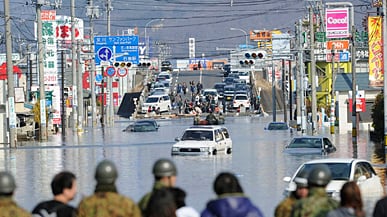Beyond the unfolding nuclear dangers, Japan has a humanitarian crisis on its hands. Over 500,000 citizens are in temporary shelters, desperate for food, water, and medical supplies. Meanwhile, rescuers workers continue to find thousands of dead bodies, with the official death toll, 1,800, thought to be much lower than the real figure. Relief workers in Iwate prefecture, near the quake's ground zero, say they have just 10 percent of the supplies they need.
See Japan’s catastrophe up close: the Fukushima reactor exploding, tsunami waves spilling over a seawall, before and after shots, and more stunning images. Plus, full coverage here.
The Daily Beast is collecting compelling photos and videos from the earthquake and tsunami in northeastern Japan. If you were there or know someone who would be willing to tell their story, please have them contact newsweektsunami@gmail.com, or send a tweet to @thedailybeast.
Shocking Photos: Quake, Tsunami Aftermath in Japan

MONDAY, MARCH 14TH
Stranded in Aoba-ku, Sendai, and in desperate need of a mobile charger? Try the janitor's room in the Aoba Street office building. Hungry for a warm meal? Try the Funky Chicken; it's located right by the central post office in town. A collaborative Google Spreadsheet has surfaced for people spread across the Miyagi Prefecture and looking for supplies. In it, tipsters are listing confirmed locations where they can find gasoline, mobile phone chargers, garbage, open baths, toilets, and banks.
This tweet is a warning to those on their way to the Miyagi Prefecture, where hundreds of thousands are in temporary shelter, and they are running low on food and gasoline. This tweet loosely translates to the following: " If you are trying to come to the disaster area: not recommended. Oil is not possible within the prefecture. In addition, in the future are expected to worsen the situation of the first nuclear power plant, due to traffic congestion around the landslide occurred just at the point of the No. 4 best approach."
RT @ seino_shinya: 被災地に来ようとしている方へ:お薦めできません。県内での給油は不可能です。また、第一原発の状況がこれから悪化すると予想される中、4号のちょうど一 番近づくポイントで土砂崩れ迂回による渋滞が発生。 #save_miyagi #151995 ... less than a minute ago via TwitBirdHiroki Nakamuranakamurahiroki
--
A video report from a Sky News correspondent shows some of the recovery efforts in Miyagi--these scenes come from the villages of Fujitsuka and Idohama. Workers and residents alike search for personal property, landmarks from a barely recognizable neighborhood, and bodies. Warning: the following contains footage of workers removing a body from the rubble at around 1:20.
--
This is video of the explosion of Fukushima's #3 reactor--a ball of fire following by a rising column of grey smoke. This is the second blast to hit the plant since the tsunami struck.
--
The following shows Japanese in Miyagi, Japan going to get water. A large tank of some kind lies on its side in the background.

--
A photo taken in Sendai earlier today shows devastation miles inland, where the @ShelterBox team is currently working on getting emergency housing-- coming from Britain.

--
Shinya Komase, a photographer living in Ichikawa, writes in with a report that many stores have run out of dry cell batteries.
"I went out to purchase some dry-cell batteries for we would have scheduled blackouts from today. However, there was nothing left at drug stores and convenience stores as I attached some photos. Sorry that the photos are blurry for I shot these with my iPhone. Even at local stationary stores and small electric stores, I could not find any dry-cell batteries. It seems that people bought most of foods, such as snacks, instant foods, sandwiches and drinks."

--
Richard Walton, an American who tells us he has worked in Japan for 20 years, writes of his kids' point of view of the historical events happening around them:
"My kids, who are just 11, 9 and 6, are already tired of the constant coverage on every TV channel. But of course they are too young to realize the history they are living through. All their friends are fine. The fact that this was the strongest earthquake in Japan in 140 years, the 3rd (or 5th) strongest in the world since 1900, the fact that the Japan coast shifted 8 feet, or the fact that the earth’s axis shifted 10 cm does not mean much to them."
He also writes of the future:
"As I write this there are still possible huge problems brewing at a nuclear power plant, nevertheless from the reports I have heard, all Japanese, even those in the worst hit areas, have retained their composure and order. That is such a nice thing about living here. Not only do you almost never feel fear, but rioting and looting are almost unthinkable. If the Japanese government can avoid repeating past mistakes of paralysis and inaction, Japan should recover rapidly."
--
Arnell, a member of the U.S. military who was actually flying to Narita airport when the earthquake struck--and therefore had no idea until he landed--writes of that experience:
"Once they turned on the news in the plane as we sat on the runway it was just unbelievable! People in the plane began to translate in english what was going on and we all sat there in shock. several hours later we were sent to Haneda airport were we were told we could not fly out of the country and that all transportation had been shut down. there were tons of people laying, sitting and sleeping all over the airport it felt like something out of a movie I remember telling some passengers. All of the resturants and shops were closed because they ran out of food and drinks. it was a bit scary to not know when you would eat again. people were in total survival mode with no regards for anyone but themself and there family."
Eventually Arnell made it home. His lesson: "Always prepare for anything because you never know when you will be stuck and without food or water is a scary feeling to have."
--
An American man living in Tokyo shared on his Facebook profile this video of a tsunami sweeping rapidly through a town and washing away everything in its path.
SUNDAY, MARCH 13TH
Russia Today has acquired footage from "Ann" that shows a tsunami wave approaching—then spilling over—a sea wall in Miyako, Japan. Fishing boats, minivans, and houses are equally destroyed by the powerful water.
A photograph posted on Twitter shows the tsunami wave's destruction in Sendai.

Residents of Tokyo and the surrounding cities are now dealing with rolling power outages. Many have taken to Twitter to alert others of the schedule.
power cut is having by rotation of area. it'll have between 6:20am-22pm. some area may have 2 times in a day. 3hrs each. #honyaquake #eqjpless than a minute ago via webtatsnaly.statsnaly
One person has posted a series of photographs from around Sendai.
Taken on the grounds outside Sendai Airport, the following shows the path of destruction left by the wave, littered with bits of wood, cars, and an airplane.

An ominous cloud of black smoke rises over Sendai in the distance.

The body of a large fish, swept in by the tsunami, lies baking in the sun.

The street beneath an overpass is littered with minivans and SUVs that had been washed inland.

The New York Times has a stunning visual gallery of before and after the earthquake satellite photographs from GeoEye, which shows the destruction of Ishinomaki, Natori, Sendai, Yuriage, Arahama, and Sendai Airport from above.
SATURDAY, MARCH 12TH
Curious what Disneyland is like when an earthquake hits? Below, a waterworks at Tokyo Disneyland gets interrupted by the 8.9 quake. In the second video, the infamous castle can be seen in the background, through the trees, as Disneyland staffers try to calm the crowds.
"In the midst of all the human tragedy in Japan," writes another Redditor as he/she posts this screen capture of Japanese TV, "we spare a thought for all their beloved furry friends as well. May they all find their way home safely!"

A Brooklyn-based sound programmer named Micah Frank and founder of the Tectonic Project—"which aggregates earthquake data from the U.S. Geological Survey and turns it into sound sculptures in real time," per PBS—has constructed a six-minute audio track that shows what an earthquake sounds like, based on the data Micah's computers analyze.
The following, its author unknown, shows satellite imagery provided by Google that depicts the Japan coastal line—before and after the tsunami.

Curious how now-homeless Japanese victims of the earthquake are being encouraged to stay warm? This hand-drawn infographic details a four-step method for constructing temporary shelter from a cardboard box.

A staffer at the Japanese Red Cross is posting photographs in real-time from the relief agency's efforts around Sendai. Below, her photograph of tsunami victims being wrapped in plastic sheets and brought into the hospital for treatment.

And here, she posts, "helicopters keep back and fowards and bring patients to Ishinomaki #RedCross hospital."

The following amateur video is haunting—it was taken from inside Sendai Airport as the tsunami swept across the parking lot and tarmac outside. People trapped there can be heard talking nervously at first, but their conversations soon turn to screams and wails as they realize the extent of the wave. ( via)
-
We have this quick report from Gavin Kingi Sato, a teacher living in Kobe, who is originally from New Zealand:
"Kev is living in Tokyo. Took him 7 hours to get home from work. Him and his wife had to turn the tv off as it was too much for them. Big aftershocks happening up there. It's absolute carnage up north, the death toll will be well over 1000 I reckon. People are going to be homeless for quite a while, it's going to take a long time to get things back to normal. Repairing buildings isn't so bad, rebuilding cities is the scale here."
Those with relatives or friends who lived in the more hard-hit cities along Japan's northeast coast are using tools like Google's Person Finder, or the Red Cross, to locate their loved ones. On Reddit, "Kasyx" writes of his lost friend, "No one has heard a word from him since the quake hit. His mother, girlfriend, and friends back in South Africa are desperately trying to make sure he is okay. Please, Reddit, if anyone knows him, has seen him, or knows of his whereabouts, now's the time." A few hours later, another user posts a relieving update: "Received this SMS from Mayi: Yeah I'm cool, in as far as sleeping on the floor of a gym with aftershocks all the time is cool. Earthquakes are fail."
More devastating footage from Japanese TV shows the roaring mouth of the Natori River, near Sendai, as the tsunami rips through farmland and houses—some of them still burning.
The following—"Please help. In Sendai, Japan right now, worried about the Fukashima reactor"—is a Reddit post from a man living in Sendai city, and illustrates the fear many in the region have of a looming radioactive disaster. His wife is pregnant, and he is worried for the child.
"I have a pregnant wife, we are living in Sendai city. If it was just me I wouldn't worry so much but I'm worried that there is a chance we could get caught in a radioactive cloud I'm worried about my developing child. Should I be moving north or am I being paranoid? We have a little gas and everything we need to wait it out in this house, north seems to be worse-off than Sendai and to get to Tokyo we have to drive through Fukashima as the motorways are closed. The TV and Radio are saying very different things and the government is holding back information. Anything that can help us make a more informed decision is welcome."
A series of satellite photographs taken by Digital Globe have been posted on Flickr.
"This is a satellite image of Japan showing damage after an earthquake and tsunami at the Kirin plant, Sendai." Notice the toppled white structures.

"This is a satellite image of Japan showing damage after an earthquake and tsunami at the Sendai Port, Japan"

"This is a satellite image of Japan showing damage after an earthquake and tsunami of the Kengaya bridge."

Shocking footage has surfaced of the tsunami sweeping through the streets in Kesennuma City. Below, watch as the waters roar through the streets, pulling trucks, cars, and houses, as the town's warning system blares over unseen loudspeakers.
Smoke can be seen rising after an explosion at a nuclear power plant in the following video, but NPR is reporting "it wasn't a nuclear explosion." Still, officials have detected increased levels of radiation in the vicinity of the Fukushima plant.
More haunting footage of the tsunami overtaking Sendai Airport. Some of the most visceral footage has come from this tarmac, presumably because of the number of security cameras that were rolling at the time the wave hit.
Cellphone footage in Yokohama Station shows hundreds of stranded travellers, many their eyes glued to cellphones, as they await trains to return home.
The following image comes from NASA's Earth Observatory, and depicts a black plume of smoke coming from the heavy-hit Sendai and drifting out into the Pacific Ocean. NASA writes, "The moderate resolution imaging spectroradiometer on NASA’s Aqua satellite acquired the image at 12:10 p.m. local time. Clouds prevented MODIS from identifying the location of the fire within the city, however this type of black smoke usually originates from oil or gas fires."

Fans of Japanese tweenage celebrities are mistakenly heartbroken this morning over Twitter-based rumors that Satoshi Tajiri, creator of Pokemon, and Yuko Shimizu, the creator of Hello Kitty, died in yesterday's tsunami. But on Saturday, the Twitter account for a Japanese fashion news blog tweeted, "Yuko Yamaguchi (Hello Kitty) and Satoshi Tajiri (Pokemon) are still alive. Please stop spreading J-celeb death rumors," in an attempt to dispel the rumors
The creator of Pokemon, and Hello Kitty both died today in the tsunami. #RIP. #PRAYFORJAPAN. less than a minute ago via webVoldemort.BieberGoesRawr Yuko Yamaguchi (Hello Kitty) and Satoshi Tajiri (Pokemon) are still alive. Please stop spreading J-celeb death rumors. #earthquakeless than a minute ago via webTokyo FashionTokyoFashion

Google unleashed its Person Finder for the Japan earthquake early Friday morning. It can be used to add known information about someone or find them.
There are reports that upward of 10,000 people are missing from Minamisanriku, a port town in northeastern Japan. This picture shows what's alleged to be what's left.

Aid workers and residents of the bigger cities to the south, like Tokyo, are having trouble reaching some of the more damaged cities in the north. Officials have closed down many of the roads leading toward Sendai, largely because of fears of an increasing nuclear disaster. The following picture, posted by @ProducerMatthew, exemplifies some of the damage to the roads that those traveling north likely face.

Back in Tokyo, this photo shows a swollen crowd at the Keio subway line, in Tokyo's Shinjuku ward.
Tom Baker, a writer living in Tokyo, has posted a compelling firsthand account of his experience as the earthquake began. An excerpt:
"In the movies, earthquakes are depicted as rumbling. But most of the ones I have experienced have been silent, while the larger ones are accompanied by a lot of squeaking and creaking. This one had plenty of that, especially since the building housing the electronics store was wiggling and jiggling like a seven-story Jell-O mold. I saw this with my own eyes."
----
Officials in Japan now fear a nuclear disaster after increased radiation levels at Fukushima Daaichi nuclear plant. Below, Reuters reports the radiation is at alarmingly high levels at the plant's main gate. There are additional reports that the pressure inside the plant's containment vessels is rising. Officials do say however "the emergency cooling system, the last-ditch measure to prevent the reactor going into meltdown, is still intact and could kick in if needed."
Radiation levels 8 times normal levels near main gate of Fukushima Daiichi nuclear plant in Japan - Kyodo less than a minute ago via webReutersBreakingNewsREUTERSFLASH
Meanwhile, the Weather Channel reports 3,000 people have been asked to evacuate after radiation levels increased to 1,000 times the normal amount.
3,000 ppl asked to evacuate in #Japan after radiation levels at nuclear pwr plant 1,000x norm. Officials say some radiation has leaked. less than a minute ago via TweetDeckTWC BreakingTWCBreaking
Much of the coverage has focused on the devastation, but the following video shows rough waters in the Santa Cruz Harbor. The user who posted this video wrote, "I was getting ready to run... but it will give you an idea of what the surge did."
This photo, posted by YukaOgura on Twitter, shows a crack running down the sidewalk alongside a wall of bikes.
A photo from Maihama Station, in Urayasu, Chiba, Japan.
The following shows a crowded gym, packed full of Japanese residents left out in the cold, many wearing jackets or blankets to stay warm.
"Waiting in line for the washroom"
This photo of destruction was posted to twitpic alongside the words, "If I live I'll be back! I'll work hard!" The poster was concerned a second, more powerful tsunami was on the way inland.
A blogger for Time Out Tokyo live-blogged the earthquake from his offices in the Japanese capital.
"I'm writing this from the Time Out office, a ground-floor room at the base of a relatively new building. Across the road there's a tenement block. It's swaying horrifically--so much so, in fact, that it looks like a miniature, as though it's been subjected to tilt shift photo technology. I can't quite compute seeing a building doing that."
In a testament to the architects and engineers of Tokyo's skyscrapers, the follow video shows the towering buildings swaying back and forth at the peak of the earthquake.
Footage via CNN and Reuters shows Sendai Airport completely underwater.
The second half of the following video shows clear footage from atop a building at Sendai Airport, in Sendai, Japan, as the sea flows across the tarmac.
A first-person video taken from what looks like a hospital ward, or a DMV of sorts, as the first tremors of the earthquake strike.
Surveillance video from a “sub shop” shows workers desperately trying to hold up shelves as the earthquake rocks the groceries to the floor.
From a distance, black smoke can be seen rising over the Odaiba port in Japan.
A shocking video showing the power of the water as waves roll over a number of fishing boats in a Japanese harbor.
A video taken from inside a living room near Aoba-ku, Sendai.
Cars, trucks, and boats are sent rushing under a bridge and over a swelling wall of water in Japan.
This screencapture allegedly shows the earthquake and tsunami as seen from space. It’s unclear whether the colors represent the flow of water or shockwaves.

PIC: “Sendai Airport completely flooded”

This popular photo, which has been viewed over a quarter of a million times, shows a group of young people peering into a gaping crack in the earth.

A surfer in Hawaii, who in a previous tweet notes there are 20 surfers in the water, notes: “The reef here was completely submerged 5 minutes.”






